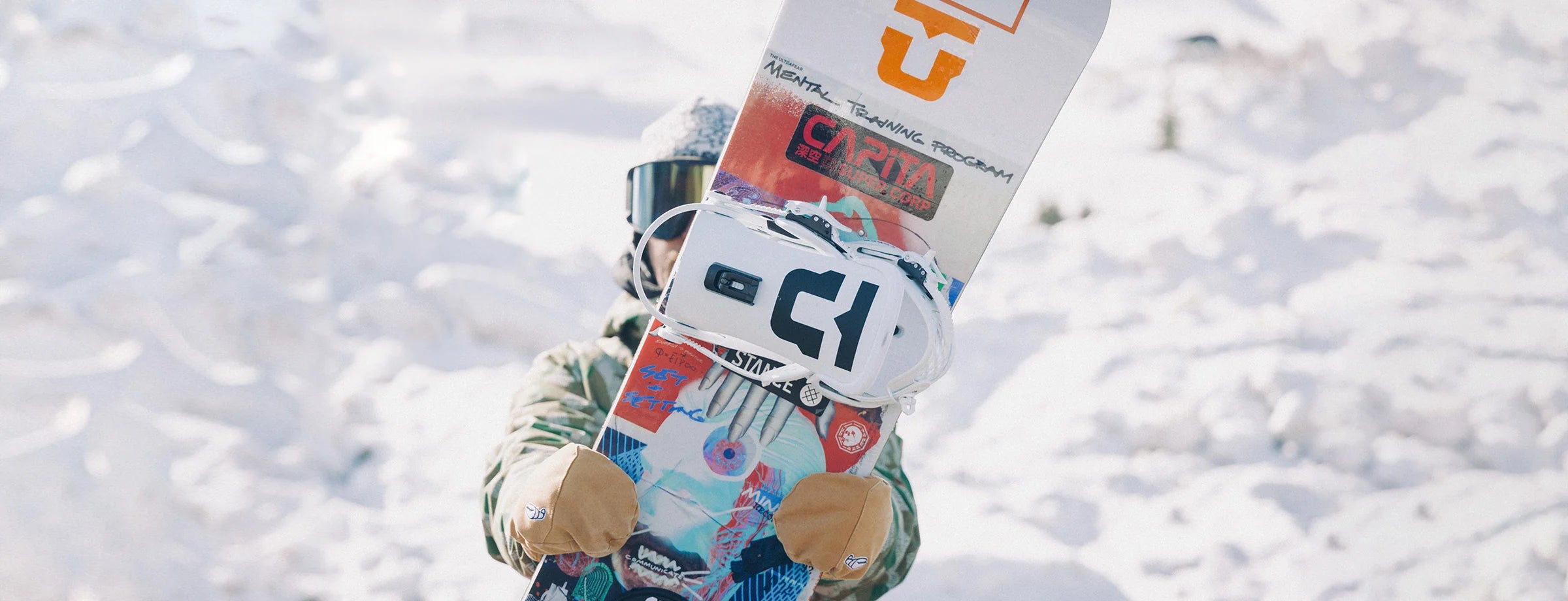If you’ve ever asked yourself, “how often should I wax my snowboard?”, you’re not alone, and you’re in the right place. Waxing is one of those maintenance tasks that feels optional until your board starts dragging or sticking. In our experience running Switch Skate and Snow in Ajax, Ontario (serving Durham Region and the GTA), we've seen too many boards neglected, and the results are a slower, less responsive ride.
If you need snowboard tune up servicing, talk to us at Switch, we've got you covered.
Today, we'll walk you through how often you should wax your snowboards, how to tell when your board needs a wax, and tips so your board stays fast, smooth, and healthy all season.
Let’s dive in.
Check out our Snowboard Tune Up services. For more information on Tune Up Services, visit our dedicated page need at switch.
Wanna tune your snowboard yourself? We've got all the tools you need at Switch!
Switch Skate & Snow:
161 HARWOOD AVE N UNIT #6, AJAX, ONTARIO, L1Z0A1
Why Waxing Matters

Waxing isn’t just about speed. It’s about preserving your board, smoothing its ride, and protecting the base from damage. Think of wax as skin lotion for your board’s base, it keeps it hydrated, resilient, and slippery.
A dry or under‑waxed base will:
-
Drag on flat terrain
-
Be more susceptible to scratches and abrasion
-
Slow you down in general
-
Promote “base burn” or whitening near edges
When you wax regularly, you maintain base saturation, reduce friction, and keep your board performing longer.
Factors That Determine Wax Frequency
There’s no one‑size‑fits‑all answer. How often to wax depends on several variables. Here are the key ones:
1. Type of Base (Sintered vs Extruded)
-
Sintered bases are porous and absorb more wax—but they also lose it faster. That means more frequent waxing.
-
Extruded bases are less porous, so they hold wax longer and are more forgiving if you miss a session.
2. Riding Conditions & Snow Type
-
Hard, icy, or dry snow tends to strip wax faster (snow crystals act like sandpaper)
-
Wet, slushy, or spring snow can also degrade warm‑temp wax more quickly.
-
Artificial snow, mixed snowpack, and abrasive terrain speed up wax loss too.
3. Riding Frequency / Intensity
-
If you’re riding full days or many days in a row, you’ll burn through wax faster.
-
If you ride lightly (a couple of hours, low speed), the wax will last longer.
4. Performance Expectation
-
If you demand top speed, responsiveness, and precision, you’ll want more frequent waxing.
-
If you ride for fun and are okay with a little drag, you can stretch it out.
General Guidelines: How Often to Wax
Here’s a rough “rule of thumb” spectrum based on what we see in the industry and what we’ve experienced at Switch Skate and Snow:
| Riding Style / Base Type | Suggested Interval | Comments |
|---|---|---|
| Aggressive / Race / Sintered base | Every 2–3 full riding days | Maximize performance |
| Moderate all‑mountain (sintered) | Every 3–5 riding days | Balanced approach |
| Extruded or casual use | Every 5–10 riding days | You’ll still feel benefits |
| Very light riding | Once a season + midseason top‑ups | But check your base regularly |
For example, EVO recommends waxing again after 3–5 days of riding as a reasonable guideline.
From our standpoint, with variable snow, we lean toward waxing every 3 riding sessions as a safe standard, unless conditions or base type demand more.
How to Tell If Your Snowboard Needs Waxing
Don’t rely solely on days ridden. Use your eyes and feel to know when it’s time:
-
Dry or matte appearance: The base loses its shine and looks chalky
-
White patches or base burn, especially near edges
-
Speed drop or drag, especially on flats
-
Fingernail test: Drag your fingernail lightly, if nothing gets “sticky” or you feel no wax, time for a hot wax
-
Uneven glide: It feels “sticky” or inconsistent
If you see any of these, wax now, even if your “interval” hasn’t passed.
Seasonal & Storage Waxing Tips
To keep your board healthy through the off-season:
-
Pre-season: Always give your board a full hot wax (or shop tune) before the first day.
-
Mid-season: Even if light use, a mid-season top-up helps maintain saturation.
-
End-of-season / Summer storage: Apply a heavy, protective wax before storing to prevent drying out.
Boards left dry over summer often greet you next season with a sticky, slow start.
Top Wax Brands to Trust (From Our Stock)
We stock some of the best snowboard wax brands here at Switch Skate and Snow. These deliver consistency, performance, and ease of use.
Here are the top options we recommend:
-
Oneball – Classic, trusted brand. Wide range of temperature‑specific waxes.
-
Dakine – Reliable all‑temp and cold/warm wax options.
We encourage you to pick wax according to your local snow conditions and your riding style. We train our techs to pick the right waxbased plan when you bring the board in for tuning.
Waxing Best Practices & Schedule Tips
Here’s how to get the most from your wax routines:
-
Remove bindings (if possible) to avoid trapping sweat or moisture under screw holes.
-
Clean the base first (wipe or use base cleaner)
-
Hot wax with correct iron temp (move iron steadily, don’t linger)
-
Scrape thoroughly at a 45° angle
-
Brush (coarse, then fine) to expose base structure
-
Use a “maintenance wax” or rub-on only on light days (no full hot wax needed then)
-
Track your waxes: Keep a little log or calendar so you don’t forget
-
Adjust in harsh conditions: If you’ve ridden in ice, gritty snow, more abrasives, wax earlier
For scheduling, we suggest:
-
Baseline wax before the first mountain day
-
A wax every ~3 riding days (adjust by conditions)
-
Top-up rub wax if you only do a short session
-
End-of-season heavy wax for storage
When Waxing Is Too Frequent or Too Rare
⚠️ Too Frequent?
There’s little risk from waxing too often—as long as you do it correctly (don’t overheat, don’t damage the base). Many say you can’t wax “too much.” Just don’t waste wax or time.
🚫 Too Rare?
If you're skipping waxes:
-
Your board slows, drags, becomes inconsistent
-
You can get base burn or whitening
-
Micro damage can occur more easily
-
You lose longevity
Imagine driving a car with under-inflated tires: you can drive it, but it’s inefficient and causes wear. Neglected waxing is similar for a snowboard.
Snowboard Waxing Routine: What It Looks Like in Practice
Here’s an example routine you might follow (or have your local shop follow):
-
Pre-season full hot wax
-
Ride day 1 → check base
-
Ride day 2 → maybe rub wax
-
Ride day 3 → full hot wax
-
Ride day 4 → depends on base
-
Ride day 5 → full wax
-
Repeat cycle, adjusting if snow is harsh
-
Mid-season check & tune
-
End-of-season protective wax
This gives roughly a wax every 3 rides with flexibility to adjust. You’ll often find that midseason you need to tighten or loosen this depending on snow quality.
Local Considerations in GTA / Durham Region
Because we serve riders around Ajax, Durham Region and across the GTA, I’ve seen these local influences:
-
Variable snow (mixed thanks to freeze-thaw, manmade snow): wax wears off faster
-
Lots of ice patches: more frequent waxing necessary
-
Frequent day trips, shorter rides: you might lean on rub‑wax maintenance
-
Rocky patches and early/late season low snow: need protective wax layers
In other words, your region’s snow tends to be more abrasive, so your real interval might skew toward the shorter end (3–4 rides) rather than long.
Why Our Snowboard Tune Up Services Are The BEST at Waxing
We don’t just toss wax on your board. At Switch Skate and Snow in Ajax:
-
Our techs assess your board type and use pattern
-
We choose a wax strategy suited to Greater Toronto / Durham snow
-
We maintain a wax log for frequent customers
-
We keep top wax stock (Swix, Burton, Toko)
-
We perform full base prep + waxing + brushing without shortcuts
The result? Our clients’ boards ride faster, last longer, and stay smooth all season.
Quick Tips / Little Hacks (Listicle Style)
-
Use rub-on wax for quick maintenance between hot waxes
-
Store boards base‑up, not flat on base
-
Wipe base with a soft cloth before waxing
-
Don’t overheat – keep your iron moving
-
Scrape fully, then brush to open base structure
-
Keep a wax journal (date, base, snow, what wax used)
-
Adjust frequency when you hit a series of icy / dry days
Final Answering to “How Often Should I Wax My Snowboard?”
To wrap up:
-
If you ride aggressively on a sintered base, aim for every 2–3 riding days
-
For moderate all‑mountain usage, every 3–5 riding days is a solid standard
-
For extruded or light riding, you can stretch up to 5–10 rides, but monitor the base
-
Always wax pre-season and post‑season, and top up mid-season
-
Use visual and tactile checks—don’t rely solely on a calendar
-
In the GTA / Durham area, leaning toward more frequent waxing is safer
Waxing is one of the simplest yet most effective ways to preserve your snowboard, maintain speed, and avoid long‑term damage. Start thinking of it as routine board care, like oil changes for a car, and your board will thank you.
FAQs
1. How many times should I wax my snowboard per season?
It depends on use, but for a typical rider in Ontario you might do 8–15 full waxes plus a few rub‑wax top-ups.
2. Can I wax more often than recommended?
Yes — as long as you're doing it properly, waxing too often isn’t harmful.
3. What happens if I forget to wax for many days?
Your board will slow down, show base burn or whitening, and be more prone to scratches and damage.
4. Can I just use rub-on wax all season?
Rub‑wax is fine for light maintenance, but it won’t penetrate and saturate the base like a proper hot wax does.
5. Does a new board need waxing right away?
Yes — factory waxes are minimal. Best practice is a full hot wax before your first ride and at the end of the season.


